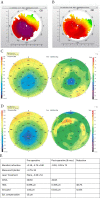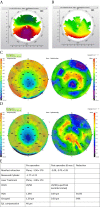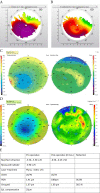A Novel Procedure for Keratoconus/Corneal Ectasia Treating Epithelial Compensation of Higher-Order Aberrations, Topographic Guided Ablation, and Corneal Cross Linking - The CREATE+CXL Protocol
- PMID: 37469861
- PMCID: PMC10352124
- DOI: 10.2147/OPTH.S411472
A Novel Procedure for Keratoconus/Corneal Ectasia Treating Epithelial Compensation of Higher-Order Aberrations, Topographic Guided Ablation, and Corneal Cross Linking - The CREATE+CXL Protocol
Abstract
Purpose: To present the outcomes of a retrospective study in keratoconus/corneal ectasia patients of treating the higher order aberrations compensated for the corneal epithelium in addition to topographic guided ablation followed by corneal cross linking.
Methods: Twenty-seven eyes of 14 patients were treated for keratoconus/corneal ectasia utilizing trans-epithelial topographic guided ablation photorefractive keratectomy (PRK) for treatment of corneal higher order aberrations and lower order astigmatism followed immediately by 15-minute cross linking were examined retrospectively. Six-month results were analyzed via measurement of vision, refraction, residual higher-order aberrations (HOAs), residual lower-order and higher-order aberrations, as well as for loss or gains of lines of best corrected visual acuity.
Results: All eyes save one had reduction in K1, K2, K Max, and K Mean. All eyes had reduction in manifest astigmatism, Contoura measured astigmatism, 57% reduction of higher-order aberrations (HOA), and 53% reduction of higher-order aberrations grouped with lower-order aberrations (Grouped). Nearly all (96.3%) eyes achieved 20/40 vision or better, 20 eyes had 1-7 lines gained of vision, and no eyes had any loss of lines of vision.
Conclusion: Use of the CREATE+CXL protocol combined with 15-minute corneal cross linking results in a significant increase in HOA reduction, as well as a significant improvement in corrected distance visual acuity over past procedures.
Keywords: astigmatism; corneal cross linking; corneal ectasia; higher-order aberrations; keratoconus; lower-order aberrations; photorefractive keratectomy.
© 2023 Motwani.
Conflict of interest statement
The author has been granted United States patent no. 10857032 concerning the creating of a more uniform cornea utilizing the topography measured astigmatism, and United States patent no. 10857033 for the treatment of epithelial compensation of corneal irregularity in conjunction with the use of topography guided ablation system. The author reports no other conflicts of interest in this work.
Figures



References
-
- Boyd K. Keratoconus diagnosis and treatment. American Academy of Ophthalmology; 2020. Available from: https://www.aao.org/eye-health/diseases/keratoconus-diagnosis. Accessed January 22, 2021.
LinkOut - more resources
Full Text Sources
Miscellaneous

